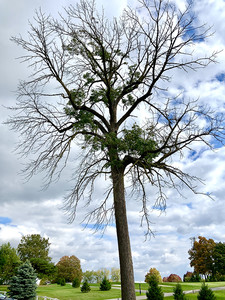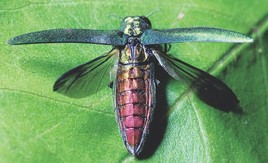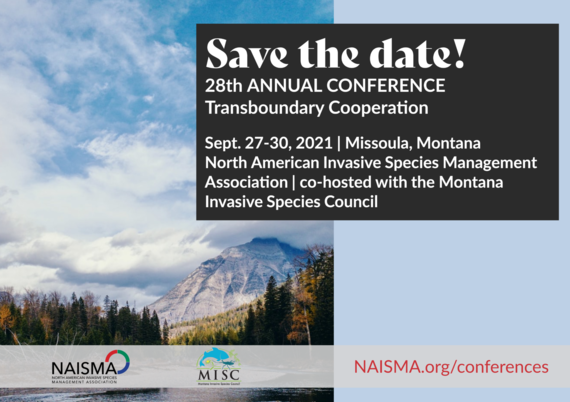|
The Invasive Species Bulletin provides you with all the latest news on invasive species in Montana and the region. Please let us know if you have any suggestions, contributions, questions, corrections, or comments. Email: scriswell@mt.gov
APHIS Changes Approach to Fight Emerald Ash Borer
WASHINGTON | Dec 14, 2020
The U.S. Department of Agriculture’s Animal and Plant Health Inspection Service (APHIS) is changing its approach to fight the emerald ash borer (EAB) infestation that has spread through much of the United States. The Agency is publishing a final rule that removes the federal domestic EAB quarantine regulations that have proved ineffective and will redirect resources to more promising methods.
APHIS has been transparent about the challenges associated with controlling the emerald ash borer and that the domestic quarantine has not proven effective in stopping its spread. The Agency has worked to identify more effective and less intrusive methods and will now direct available resources toward non-regulatory options for management and containment of the pest, such as rearing and releasing biological control agents. Results have already proved effective and the actions announced today will allow the Agency to increase their use.
Removing the quarantine regulations ends APHIS’ domestic regulatory activities, which includes actions such as issuing permits, certificates and compliance agreements, making site visits, and conducting investigations of suspected violations.
The final rule and the response to the comments we received will publish in the Federal Register on December 15, 2020 and be rule will be effective on January 14, 2021. Documents may be viewed online at https://www.regulations.gov/docket?D=APHIS-2017-0056 [gcc02.safelinks.protection.outlook.com] upon publication.
APHIS is working with the National Plant Board on effective strategies to manage firewood movement, which is one of the ways the emerald ash borer spreads.
APHIS’ goal is still to maintain ash in the North American landscape. We look forward to continued collaboration with our partners on this effort. Questions about the regulatory change for emerald ash borer can be directed to National Policy Manager Herb Bolton at 301-851-3594 or Herbert.Bolton@usda.gov.
 |
|
Ash trees are weakened as emerald ash borer larvae feed under their bark. The invasive pests eventually kill the trees and have been spreading throughout the United States for nearly two decades.
(Photo provided by Songlin Fei)
|
Firewood Outreach Coordinating Initiative
Protect the Trees You Love From Tree-killing Bugs
They give you shade. They provide oxygen. Let’s make sure trees everywhere can do the same for future generations. If you’re a camper heading out for a trip — or just getting firewood for your wood stove — do nature a favor. Don’t move firewood long distances — it can potentially transport invasive species. Instead, buy it where you’ll burn it, buy certified heat-treated firewood — or gather on site where permitted. The forests, and your great-great-grandkids, will thank you. Read more.
AIS Grants Available!
The Montana Invasive Species Council is now accepting grant applications to fund aquatic invasive species projects. Up to $50,000 is available per project to Montana communities or local, state, tribal, or other entities within the state and to Montana-based non-governmental entities. AIS Grant Program Guidelines.
Deadline February 4, 2021.
 Christmas trees, wreaths and decoration may contain forest pests.
Holiday Greenery: Christmas Trees, Wreaths & Decorations May Contain Forest Pests
Live trees are wonderful, and here at Don’t Move Firewood we think the benefits of buying and enjoying a live ‘real’ Christmas tree are far greater than the risks. Read more.
FWP AIS Strategic Plan
Montana Fish, Wildlife and Parks seeks feedback on the draft AIS Strategic Plan Goals and Strategies. Participants at the 2019 AIS Summit in Helena provided feedback and ideas that were compiled into the draft plan. Public input is now an important part of developing and finalizing this document. View the draft AIS Strategic Plan Goals and Strategies and submit your comments.
NW RISCC Survey Update
Several regional agencies and organizations have partnered to create the Northwest Regional Invasive Species and Climate Change (NW RISCC) Network, a community of practice dedicated to helping practitioners address the nexus of climate change and invasive species, including plants, animals, and pathogens.The objective is to help practitioners within federal, tribal, state, and local agencies and conservation organizations integrate climate change science and adaptation with invasive species prevention, early detection, control, monitoring, and research activities.
NW RISCC is seeking input from individuals with interest and/or experience in invasive species management and climate change adaptation, such as scientists, resource managers, conservation practitioners, field crew personnel, fire managers, agency leads, agricultural specialists, and more. Input will be used to help shape the strategic agenda and action plan for the Network, including partnership and funding opportunities. The survey should take ~10-15 minutes to complete, and responses will be summarized (without names) and shared with respondents. Survey closes the December 21.
Click the link below to complete the survey about invasive species in a changing climate. Final survey results and next steps planned for January 21, 2021. Contact Rachel Gregg for more information.
survey [gcc02.safelinks.protection.outlook.com]
The Updated Recommendations for the Quagga Zebra Action Plan for Western U.S. Waters (QZAP 2.0)
The purpose of the QZAP 2.0 is to provide a systematic and unified approach to prevent the spread of zebra and quagga mussels into and within the western US in the future. These recommendations are intended to inform decision‐making to provide increased capacity and clear direction that empowers the further implementation of a collaborative multi‐jurisdictional regional strategy to prevent the spread of quagga and zebra mussels in the West.
The original QZAP and the 2019 Status Report can be found here.

A Silent Killer: Black Ash Basket Makers are Battling a Voracious Beetle to Keep Their Heritage Alive
American Indian Magazine | Spring 2020
Smaller than a penny, deceptively beautiful emerald ash borer beetles killed millions of as trees in North America during the past two decades. Photo by David Cappaert.
It is easy to default to thinking about green ash when considering the impacts of emerald ash borer, but as the affected region expands across the US and Canada, black ash is going to see increasing impacts on ecosystems, forestry, and culture. For a good read on traditional black ash basketry, click here.
|
More news:
MSU Extension Service Weed Post / Common St. Johnswort - December 2020
Western Integrated Pest Management Center News - December 2020
AIS Summit addresses COVID-19 effects on increased watercraft traffic and inspection station protocols ,11/25/20, charkoosta.com
Feral Swine Remain At Bay In Montana, mtpr.org
First murder hornet nest found to have 200 queens capable of spawning new nests,11/10/20, theguardian.com
Events
Jan. 4, 2021, 2021 Montana State Legislature Convenes, Helena
Jan. 7, 2021, MT AIS Grant Hearings, Virtual
May 18-20, 2021, North American Invasive Species Forum, Montreal, Quebec
Sept- 27-30, 2021, North American Invasive Species Management Association Conference co-hosted with MISC, Missoula

Publications
The Elephant in the Lab (and Field): Contamination in Aquatic Environmental DNA Studies [frontiersin.org]
The rapid evolution of environmental (e)DNA methods has resulted in knowledge gaps in smaller, yet critical details like proper use of negative controls to detect contamination. Detecting contamination is vital for confident use of eDNA results in decision-making. We conducted two literature reviews to summarize (a) the types of quality assurance measures taken to detect contamination of eDNA samples from aquatic environments, (b) the occurrence, frequency and attribution (i.e., putative sources) of unexpected amplification in these quality assurance samples, and (c) how results were interpreted when contamination occurred. In the first literature review, we reviewed 156 papers and found that 91% of targeted and 73% of metabarcoding eDNA studies reported inclusion of negative controls within their workflows. Read more.
When Extinction is Warranted: Invasive Species, Suppression-Drives, and the Worst-Case Scenario
Thresher, A. C. (2020). When Extinction is Warranted: Invasive Species, Suppression-Drives, and the Worst-Case Scenario. Ethics, Policy & Environment.
Abstract: Most current techniques to deal with invasive species are ineffective or have highly damaging side effects. To this end suppression-drives based on clustered regularly inter-spaced short palindromic repeats (CRISPR/Cas9) have been touted as a potential silver bullet for the problem, allowing for a highly-focused, humane, and cost effective means of removing a target species from an environment. Suppression-drives come with serious risks that seem to warrant appeals to the precautionary principle, however, wherein our lack of understanding of the risks and relevant probabilities is taken as reason to avoid deploying the drive. The focus of this paper is on one such risk – the danger of a suppression-drive escaping containment and wiping out the target species globally. Here, I argue that in most cases this risk is significant enough to warrant holding off on the technology. In some cases, however, we can bypass the precautionary principle by using a dominance approach that hinges on what I term the ‘Worst-Case Clause’. This clause, in turn, provides us with a litmus test that can be fruitfully used to determine what species are viable targets for suppression-drives in the wild. Using this metric in concert with other considerations, I suggest that only three species are currently possible viable targets – the European rabbit, ship rat, and Caribbean Tree Frog. Read more.
Webinars
January 22, 2021, 9:00-10:00 a.m. EDT - Hemlock Rescue! Collaborating to stop the spread of hemlock woolly adelgid. Hemlock woolly adelgid has killed hundreds of thousands of hemlock trees in eastern states, including significant areas in the Appalachian and Great Smoky mountains. When infestations began spreading in West Michigan, a team of technicians went to work to “hold the line” through rigorous survey and treatment of infested trees in an effort to save Michigan’s 170 million eastern hemlocks from the same fate. Click here for information and to register.
January 2021 Wisconsin Tribal Conservation Advisory Council, Emerald Ash Borer Web Series Every Thursday afternoon for at least six consecutive weeks, on a variety of regional themes. Click here for more information and to register.
Webinar Recordings
Western Governors Association Invasive Species Data Mobilization Campaign
Montana AIS Summit – Nov. 18 (enter passcode 9#CG+Ul6 when prompted)
USACE: Invasive Watermilfoil Management - Nov. 12
Columbia Basin CWMA - Nov. 12
USACE: Flowering Rush - Nov. 4
Funding Opportunities
Montana DNRC Forestry Division - Montana Forest Action Plan Implementation Program. Request For Proposals. Deadline: January 29, 2021
Aquatic Invasive Species Grants. Deadline: February 4, 2021 by 5 p.m.
|